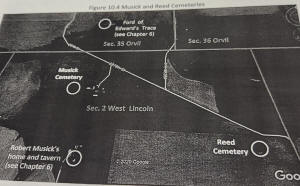|
 As
he began the presentation, Dodson said he hoped everyone was ready
for a test because he was giving one. He then asked several
questions to get everyone’s thinking processes going and find out
how much they already knew about the subject. As
he began the presentation, Dodson said he hoped everyone was ready
for a test because he was giving one. He then asked several
questions to get everyone’s thinking processes going and find out
how much they already knew about the subject.
The first question Dodson asked was the original name of Edward’s
Trace.
One person said she thought it was Kickapoo, but Dodson said it was
simply called the Old Indian Trail, which is all he found in his
research. The word trace means trail. Dodson said the word trace was
used in the early years of history.

The trail started way down south in Kaskaskia and
ended way up north in Galena. Dodson said some thought it started
near Edwardsville because Governor Edwards recruited 350
frontiersmen to go North and destroy all the Indians.
An interesting fact Dodson shared about the people who live in
Kaskaskia is that they have a Missouri address, but an Illinois Zip
Code and telephone number. They also vote in Illinois.
Nearly 3,000 years ago, the trail was developed by wild animals such
as buffalo, elk, deer, bears and several other animals. When these
animals developed the trail, Dodson said they were looking for
water, protection, and food just like men did as they walked through
the area.
The trail was in use by the animals that developed it before man.
Dodson said man came along and claimed it for their use.
Next, Dodson asked those in attendance if they knew where German
Prairie was.

Nobody could answer the question, so Dodson told
everyone German Prairie is now called Bissell, which many have heard
of. Part of the Edwards Trace went up towards Bissel and swerved
back over.
When Dodson asked if anyone had heard of Devil’s Hoe, a few people
raised their hands. He said Devil’s Hoe was a stopping off ground
for Native Americans and some early settlers. Devil’s Hoe is right
across the area from Clear Lake.
If Dodson were to take someone on a walk and point to a directional
marker, he said it would not be a sign, but would be a tree trunk
that has been bent. The bent over trees function as pointers Indians
developed in making trails.

Dodson asked how many trails join in to Edwards Trace
and said there are millions. These include the Pekin Trail.
Illinois was originally part of the Northwestern Territory. Dodson
said the river was the stopping off point. Anything west was like a
no man’s land.
Instead of pensions, Dodson said the government would give people
land. They did not come up with true pensions until after the Civil
War.
Another question Dodson asked was who was the first person to live
in Lincoln.
One man knew it was a woman who had been kidnapped in Kentucky but
could not recall her name.
The woman’s last name was Gilman and she had three children. Dodson
said Native American’s kidnapped them. In one book Dodson read, it
said the Indians brought the family up the Edwards Trace. However,
he said they actually went through Kentucky and up through Ohio.
They then crossed over Vincennes, went up to Decatur on another
trail and came out at Elkhart.

Many have heard the Kickapoo Indians were mean and
ferocious, killing anyone who got in the way, but Dodson said it was
not true. He said the tribe was not ferocious until you got in their
way and wanted a fight.
It was the Kickapoo Indians who kidnapped Mrs. Gilman and her
children, but they made sure to stop and get them game to eat and
furs to wrap the children’s feet. They never got beaten or anything
during the three years the tribe had them.
After three years, the family was ransomed back to Gilman’s husband.
Mrs. Gilman got 165 acres, but moved down to the Belleville area and
started another farm.
When Dodson asked if anyone knew where the American Bottoms is, Bill
Donath said he knew it was down by the Kaskaskia area.
Dodson said it is near Cahokia Mounds, which was the first
introduction to American soils. He asked whether the farmers that
came from Kentucky, the East Coast and other Southern states knew
how to grow crops in the prairielands of Illinois.

One man said they did not know how to grow crops here
because they thought with the prairie grass, they had to clear the
lumber to get anything to grow. They did not have plows that would
cut this soil.
In this area, Dodson said the people from the other areas did not
know how to farm in this place. It was Indians who taught people to
plant crops like corn, beans and squash.
Edwards Trace stayed in place until 1840, when the Alton and
Sangamon Railroad closed it down.
When Dodson asked if Elkhart, Elkhart Hill and Elkhart Grove are all
the same location, some thought they were.
Actually, these are three different locations. Elkhart is the town,
Elkhart Hill is the hill rising above it and Elkhart Grove is where
there were trees and hotels.
Sometimes Elkhart was called fire city because of the fires. Dodson
said at one point, some of the town was lost in a fire. John Gillett
lost his house and ten businesses burned down. Governor Oglesby also
lost his house.
[to top of second column] |

General Edwards was told to do a search and destroy
mission. Dodson said there was brutality never seen before as his
troops burned and destroyed every native property they could find as
well as all their food storages. He said that is how they got rid of
the Indians who were not causing them any problems until they were
confronted.
Illinois is one of five states not allowed by law to
have [Native American] reservations. Dodson said Illinois is also
one of two states that had the most tribes. The Souix Indians were
one of the major tribes in Northern Illinois.
When he start talking about the Old Indian Trail going down into the
Edwards Trace, Dodson said the trail started in Northern Illinois
and people worked their way down. Most of the tribes in Illinois
came across Ohio and Indiana then down through Illinois.
Around Eminence, Dodson said there was gold that had fallen out of
the glaciers and people thought they had struck it big.
If you follow the Edwards Trace, Dodson said you will
find it followed the path right along with our mother road Route 66,
Interstate 55, Interstate 155 and Route 4.
Someone asked how people got across the Sangamon River, and Dodson
said they looked for a shallow place.

Thousands of years ago, Dodson said the Wisconsin
Glacier covered Illinois down to Shelbyville. These glaciers dug all
of our creeks and rivers. The floodwaters from the glaciers cut the
Sangamon Channel. We know Sangamon River is a river because of the
signs there.
As the glaciers receded, they left behind great deposits of fertile
soil and forests. Dodson said there were almost three feet of
topsoil in some spots due to the glaciers.
When four legged animals make a new trail, then Native Americans
walk on it, then horses and later stagecoaches, it compacts the
topsoil. Dodson said when the soil is compacted, it makes a
traceable trail.
As retired Illinois State Museum Director Michael
Wiant has said, people travelled on trails in Illinois and elsewhere
between 12,000 and 14,000 years ago. Streams and rivers were not the
only means of overland travel.



After all this time, Dodson said there are still
visual signs of the trail remaining in our soil near Elkhart, Lake
Springfield, near Henson Robinson, Rochester and further south in
Macoupin County.
Along the trails, Dodson said you can find mounds. Going out near
Devil’s Hoe and Clear Lake, he said you can find several mounds.
Recently, Dodson said there was a farmer building a brand new shed.
In the process of putting up a pole barn, the man realized it was on
top of a mound. When the state found out, Dodson said they
red-flagged it and the man could not build.
When I-55 was built, Dodson said the work was stopped until
everything could be checked out. Many relics were found there.
In Dixon Mounds, there are bones that will always be there. Dodson
said the government said these bones should go back to the tribes,
but many of these tribes no longer exist.
One reminder Dodson gave everyone is that “Native American” is the
preferred term. He said Native Americans will say Indians refers to
the people from India.

Land was taken from the Native Americans who did not
have paperwork. They were here before the white man, but they did
not end up with the land.
Native Americans were great farmers and Dodson said they went to
Funks Grove in McClean County for their sugar groves, which was an
important food source in the spring. The tribes travelled the same
trails over and over through the year. The Native Americans required
a source of water and game and travelled yearly to plant their
crops.
Near I-55 by Kickapoo Creek, one man said when the work was stopped,
it was determined there was just a temporary village there in the
spring.
Over at Memorial Park, Dodson said there is the main
village. Up by Lexington, there was another major village. When
Edwards went up with his men, he wiped out these villages.
Illinois was certified as a state in 1818. In 1832, Andrew Jackson
and Edwards got the removal act put into force. Dodson said the
Native Americans did not deserve it. They helped the white man learn
how to plant and treat sicknesses with herbs.
Dodson said you should have history talk for you and have it be your
evidence. When Dodson was a State Trooper, he learned to look at all
the material before him and not stop until he could not find
anything else.
[Angela Reiners]
Related
resources
Furry, William. “Barely a Trace.”
Sielaff, Anna. “Student project tells the story of Edwards Trace.”
10 Oct. 2022, hool.Illinois.edu.
Others who were helpful to Dodson’s research include Robert Messner,
David Brady, Luke Moore and Tracy Garrison.
The Academia database has several articles on the topic.
Edwards Trace binder at LCGHS (it cannot be checked out, but pages
can be copied)
 |